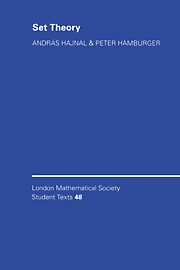Book contents
- Frontmatter
- Contents
- Preface
- Part I Introduction to set theory
- Appendix. An axiomatic development of set theory
- Part II Topics in combinatorial set theory
- 12 Stationary sets
- 13 Δ-systems
- 14 Ramsey's Theorem and its generalizations. Partition calculus
- 15 Inaccessible cardinals. Mahlo cardinals
- 16 Measurable cardinals
- 17 Real-valued measurable cardinals, saturated ideals
- 18 Weakly compact and Ramsey cardinals
- 19 Set mappings
- 20 The square-bracket symbol. Strengthenings of the Ramsey counterexamples
- 21 Properties of the power operation. Results on the singular cardinal problem
- 22 Powers of singular cardinals. Shelah's Theorem
- Hints for solving problems of Part II
- Bibliography
- List of symbols
- Name index
- Subject index
15 - Inaccessible cardinals. Mahlo cardinals
Published online by Cambridge University Press: 10 May 2010
- Frontmatter
- Contents
- Preface
- Part I Introduction to set theory
- Appendix. An axiomatic development of set theory
- Part II Topics in combinatorial set theory
- 12 Stationary sets
- 13 Δ-systems
- 14 Ramsey's Theorem and its generalizations. Partition calculus
- 15 Inaccessible cardinals. Mahlo cardinals
- 16 Measurable cardinals
- 17 Real-valued measurable cardinals, saturated ideals
- 18 Weakly compact and Ramsey cardinals
- 19 Set mappings
- 20 The square-bracket symbol. Strengthenings of the Ramsey counterexamples
- 21 Properties of the power operation. Results on the singular cardinal problem
- 22 Powers of singular cardinals. Shelah's Theorem
- Hints for solving problems of Part II
- Bibliography
- List of symbols
- Name index
- Subject index
Summary
We defined the concepts of inaccessible and strongly inaccessible cardinals in Section 10. In Section A9 of the Appendix, we discussed some consistency results and problems connected with inaccessible cardinals greater than ω. We mentioned there that the assumption of the existence of such cardinals appears to be a natural extension of the axiom system of set theory. In what follows, we will study assumptions that lead to the existence of larger and larger cardinals. The consistency questions for such extensions are similar to those discussed in the Appendix. Roughly speaking, the nonexistence of new, larger cardinals is always relatively consistent, while the relative consistency of their existence is unprovable.
Before we start searching for cardinals larger than merely inaccessible, we will sketch a model-theoretic characterization of inaccessible cardinals. We will not use this characterization afterwards, so readers not conversant in mathematical logic may well want to skip this discussion.
In what follows, we will mainly study the set-theoretical properties of large cardinals. In order to express “how large” these cardinals are, it is, however, best to use methods from mathematical logic. Theorem 15.1 is perhaps the simplest example for the application of such methods.
Definition 15.1.Let L′ be the language of set theory supplemented with a one-place relation symbolA.
- Type
- Chapter
- Information
- Set Theory , pp. 184 - 189Publisher: Cambridge University PressPrint publication year: 1999



